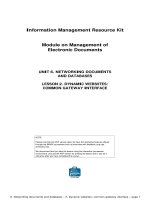unit 2 networking infrastructure
Bạn đang xem bản rút gọn của tài liệu. Xem và tải ngay bản đầy đủ của tài liệu tại đây (4.04 MB, 78 trang )
<span class="text_page_counter">Trang 1</span><div class="page_container" data-page="1">
<b>ASSIGNMENT FRONT SHEET</b>
<b>QualificationBTEC Level 5 HND Diploma in ComputingUnit number and titleUnit 2: Networking Infrastructure </b>
<b>Student declaration</b>
I certify that the assignment submission is entirely my own work and I fully understand the consequences of plagiarism. I understand that making a false declaration is a form of malpractice.
<b>Student’s signatureGrading grid</b>
</div><span class="text_page_counter">Trang 2</span><div class="page_container" data-page="2"><b>Submission format </b>
</div><span class="text_page_counter">Trang 3</span><div class="page_container" data-page="3"><b>Part 1</b>
The submission is in the form of an individual written report. This should be written in a concise, formal business style using single spacing and font size 12. You are required to make use of headings, paragraphs and subsections as appropriate, and all work must be supported with research and referenced using the Harvard referencing system. Please also provide a bibliography using the Harvard referencing system. The recommended word limit is 2,000–2,500 words, although you will not be penalized for exceeding the total word limit.
● Evidence of an implemented network.
You are required to make use of headings, paragraphs, subsections and illustrations as appropriate, and all work must be supported with research and referenced using the Harvard referencing system.
<b>Unit Learning Outcomes</b>
</div><span class="text_page_counter">Trang 4</span><div class="page_container" data-page="4">LO1: Examine networking principles and their protocols.
</div><span class="text_page_counter">Trang 5</span><div class="page_container" data-page="5">LO3: Design efficient networked systems.
LO4: Implement and diagnose networked systems.
<small>Resources: 50 student lab computers, 35 staff computers, 3 printers</small>
<small>Building: 3 floors, all computers and printers are on the ground floor apart from the IT labs – one lab located on the first floor and another located on the second floor</small>
<small>As a first task, the CEO of the company Mr. Nguyen has asked you to investigate and explain networking principles, protocols and devices and submit a report.</small>
<small>Part 1</small>
<small>You will need to produce a report that includes the following:</small>
</div><span class="text_page_counter">Trang 7</span><div class="page_container" data-page="7"><small>4.Effectiveness of networking systems.</small>
<small>5.Discussion on operating principles of networking devices and server types and networking software.</small>
<small>6.Discuss the relationship of workstation hardware with networking software.</small>
<small>7.Explore a range of server types and justify the selection of a server, considering a given scenario regarding cost and performance optimization.</small>
<small>8.For the given specification, identify the topology protocol for the efficient utilization of a networking system.</small>
<small>The CEO Mr. Nguyen is happy with your first report and now he has asked you to analyze the specification from the institution, as givenearlier.</small>
<small>You need to design and implement the networking project within a given timeframe:</small>
<small>Part 2 Design efficient networked systems</small>
<small>1.Prepare a written step-by-step plan of how you are going to design a Local Area Network including a blueprint of your LAN. </small>
<small>2.Justify your choice of devices for your network design.</small>
<small>3.Produce a test plan to evaluate this design for the requirements of bandwidth and cost constraints as per user specifications.</small>
<small>4.Justify the security requirements and quality of services needed for selection of accessories. </small>
</div><span class="text_page_counter">Trang 9</span><div class="page_container" data-page="9"><small>1.Implement a networked system based on your prepared design. </small>
<small>2.Conduct verification with e.g. Ping, extended ping, trace route, telnet, SSH, etc. </small>
<small>3.Record the test results and analyze these against expected results.</small>
<small>4.Investigate what functionalities would allow the system to support device growth and the addition of communication devices. </small>
<small>5.Discuss the significance of upgrades and security requirements in your recommendations.</small>
<b>ASSESMENT CRITERIA </b>
</div><span class="text_page_counter">Trang 10</span><div class="page_container" data-page="10">Learning Outcomes and Assessment Criteria
</div><span class="text_page_counter">Trang 11</span><div class="page_container" data-page="11">Pass Merit DistinctionLO1 Examine networking principles and their protocols
<b>LO1 & 2</b>
<b>D1 Considering a given scenario, </b>
identify the topology protocol selected for the efficient utilization ofa networking system.
P1 Discuss the benefits and constraints of different network types and standards.P2 Explain the impact of network topology, communication and bandwidth
M1 Compare common networkingprinciples and how protocols enable the effectiveness of networked systems.
LO2 Explain networking devices and operationsP3 Discuss the operating principles of
networking devices and server types.P4 Discuss the inter-dependence of workstation hardware with relevant networking software.
M2 Explore a range of server types and justify the selection of aserver, considering a given scenario regarding cost and performance optimisation.
LO3 Design efficient networked systemsP5 Provide a logical/physical design of the networked system with clear explanation and addressing table.
P6 Evaluate the design to meet the requirements.
M3 Install and configure network services and applications on your choice.
D2 Design a maintenance schedule to support the networked system.
</div><span class="text_page_counter">Trang 12</span><div class="page_container" data-page="12">LO4 Implement and diagnose networked systems
</div><span class="text_page_counter">Trang 13</span><div class="page_container" data-page="13">P7 Implement a networked system based on a prepared design.
P8 Document and analyse test results against expected results.
M4 Recommend potential enhancements for the networked systems.
D3 Use critical reflection to evaluate own work and justify valid conclusions.
</div><span class="text_page_counter">Trang 15</span><div class="page_container" data-page="15">Complete and fill all required data in the Front page with scan digital signature.
Fonts : Calibri, Font size 12, Line spacing 1.5, use of : Headings, Paragraphs, Subsections and illustrations as appropriate is required.
<b>Table of Contents</b>
<small>1Discuss the benefits and constraints of different network types and standards.9</small>
<small>4Discuss the inter-dependence of workstation hardware with relevant networking software.125M3 Install and configure network services and applications on your choice.13</small>
List of Figures List of Tables
</div><span class="text_page_counter">Trang 17</span><div class="page_container" data-page="17"><b>1.Introduction </b>
By the requirements of director of company. We were visited A school and knew resource of this school had has, for solution problem we need to built cloud system with high speed LAN and strong security, easy to use, easy to manager display and cheap.Here is the project that I come up with:
<b>1 Discuss the benefits and constraints of different network types and standards.</b>
<b>1.1.Define network:</b>A network is a collection of two or more computers or devices (such as servers, routers, switches, and other hardware) that are linked together to share resources, exchange data, and interact with one another.
</div><span class="text_page_counter">Trang 19</span><div class="page_container" data-page="19">o Benefit of LAN:
+ A local area network (LAN) allows users to share resources such as printers, scanners, and storage devices. This lowers the expense of purchasing and maintaining separate devices for each user. + Users may quickly exchange files and data among themselves, enhancing cooperation and productivity.
+ LAN enables administrators to administer and maintain the network from a centralized place, making it easier to monitor and solve difficulties.
+ LAN may be guarded using firewalls, encryption, and other security measures, therefore protecting important data and information from unwanted access.
</div><span class="text_page_counter">Trang 20</span><div class="page_container" data-page="20">o Constraint of LAN:
</div><span class="text_page_counter">Trang 21</span><div class="page_container" data-page="21">+ A local area network (LAN) allows users to share resources such as printers, scanners, and storage devices. This lowers the expense of purchasing and maintaining separate devices for each user.
+ Users may quickly exchange files and data among themselves, enhancing cooperation and productivity.+ LAN enables administrators to administer and maintain the network from a centralized place, making it easier to monitor and solve difficulties.
+ LAN may be guarded using firewalls, encryption, and other security measures, therefore protecting important data and information from unwanted access.
● WAN: (Wide Area Network) refers to a sort of computer network that spans a broad geographic region, such as a city, nation, or even the entire planet. WANs are used to link devices that are physically separated from one another, such as computers indifferent offices or towns.
Unlike a LAN, which is limited to a single building or campus, a WAN may connect numerous cities, nations, or even continents. To send data across great distances, WANs typically use telecommunication technologies such as leased lines, satellites, and wireless connections.
</div><span class="text_page_counter">Trang 23</span><div class="page_container" data-page="23">Figure 2 WAN (source: Thegioididong.com)
</div><span class="text_page_counter">Trang 24</span><div class="page_container" data-page="24">system failure.
</div><span class="text_page_counter">Trang 25</span><div class="page_container" data-page="25">o Constraint of WAN:
+ Latency is the amount of time it takes for data to transit from one point on the network to another. Due to the enormous distances that data must travel between multiple sites, latency in WANs can be considerable. This might create network delays and slow down performance.
+ The quantity of data that may be transferred via a network in a given length of time is referred to as bandwidth. WANs frequently have limited capacity, which can result in poor data transmission speeds and network congestion. + WAN are frequently used to connect many offices or distant employees to a centralized network. If the network is not adequately protected, this might lead to security vulnerabilities, possibly exposing sensitive data to unauthorized access.
+ WAN are frequently created with several linked lines and devices, which can lead to failure spots. If one connection or device fails, the entire network may fail or become unreachable.
+ Because to the requirement for specialized equipment and high-speed connections, building and maintaining a WAN can be costly. Smaller enterprises and organizations may find it harder to install and maintain a WAN as a result.● MAN: Metropolitan Area Network (MAN) refers to a form of computer network that spans a wider geographic region than a
Local Area Network (LAN) but is smaller than a Wide Area Network (WAN) (WAN). MANs may generally cover tens of kilometers, such as a city or a university.
MANs are intended to connect numerous LANs and provide more bandwidth and quicker communication between devices within the same metropolitan area. Businesses, institutions, and government entities frequently utilize them to link various sites within a city or campus.
</div><span class="text_page_counter">Trang 55</span><div class="page_container" data-page="55">Figure 9 Hybrid Topology (source: guru99.com)
o Advantages:
▪ It is the simplest approach to discover and resolve faults.▪ It provides a highly effective and adaptive networking structure.▪ It is scalable, allowing you to expand your network.
o Disadvantages:
▪ Hybrid topology design is difficult.
</div><span class="text_page_counter">Trang 56</span><div class="page_container" data-page="56">▪ It is one of the most expensive processes.
</div><span class="text_page_counter">Trang 57</span><div class="page_container" data-page="57"><b>2.3.Communication and Bandwidth:</b>
• Define commutations in terms of networking: Communication is the process of switching packets between network tiers in order to transmit data. Network communication also enables programs to communicate with one another without concern for hardware.
• Rules of communication:
o To communicate, a protocol is required.
o To offer you with internet, you must have a network topology.o Choose an appropriate network type.
o Choose an appropriate switch or router.
</div><span class="text_page_counter">Trang 59</span><div class="page_container" data-page="59"><b>3 Discuss the operating principles of networking devices and server types.</b>
<b>3.1.Discuss 1 or 2 operating principles of a selected network device </b>- Modern: To connect to the internet, devices or hosts must have a modem. A modem is a machine that connects yourhouse to your internet service provider. The network operates on a topology and protocols, however if you wish to connect to the internet, you will need a modem.
</div><span class="text_page_counter">Trang 61</span><div class="page_container" data-page="61">- Modem operation theory: To function and transmit Wi-Fi in the region of usage, our computer must be connected tothe internet via modem from our internet service provider. This modem will be linked to the Internet connectionsupplied by the network provider. A modem can also function as a computer translator. Because computers onlycomprehend the language of 0's and 1's, the modem will modulate the signal into the computer's language. The signal
will then reach the IP hub and be converted to digital form. This digital can readily flow across telephone lines after ithas been modified. Afterwards you may access the internet. You can obtain a high-speed internet connection from the
provider by increasing the number of access lines and updating the modem technology.
Figure 10 Modem operation theory (source: thongrobot.wordpress.com)
<b>3.2.List network devices [6]</b>
• Switch: A switch is a network device that links local area network devices (LAN). It scans data packets' destination MAC addresses and sends them to the appropriate port, letting devices to connect directly and effectively. Switches are vital or network connectivity and come in a variety of sizes and configurations.
</div><span class="text_page_counter">Trang 63</span><div class="page_container" data-page="63">Figure 11 Switch (source: vienthongxanh.vn)
Router: is a network device that links various networks and routes data packets based on the destination IP address. Itincludes security measures as well as network address translation. Routers are required for device connection via the
Internet and are utilized in many networks for connectivity and security.
</div><span class="text_page_counter">Trang 65</span><div class="page_container" data-page="65">Figure 12 Router (source : www.asus.com)
Access point: An access point is a device that allows devices to connect wirelessly to a wired network. It expands awireless network's coverage area and relays data packets between the wireless device and the wired network. Wireless
</div><span class="text_page_counter">Trang 66</span><div class="page_container" data-page="66">access points are extensively utilized in various networks to enable mobility and flexibility.
</div><span class="text_page_counter">Trang 67</span><div class="page_container" data-page="67">Figure 13 Access Point (source: hugotech.vn)
<b>3.3.List server types: [5]</b>
- Web server: A web server is a computer system or software program that uses HTTP or other web protocols to provide web content and services over the Internet. It provides static and dynamic information and may be used in conjunction with web apps to create a variety of services. Web servers are required for the transmission of web content and services.
</div><span class="text_page_counter">Trang 69</span><div class="page_container" data-page="69">Databases server [4]: A database server is a system or program that offers database services such as data storage,management, and retrieval. It supports a variety of DBMS and database types and may be installed in a variety of ways.
Database servers are required for data management and storage in a variety of applications and contexts.
</div><span class="text_page_counter">Trang 70</span><div class="page_container" data-page="70">-Figure 15 Databases server (source : )
</div><span class="text_page_counter">Trang 71</span><div class="page_container" data-page="71">Discuss the inter-dependence of workstation hardware with relevant networking software.
Explain what is meant by interdependencies: Interdependence refers to interactions between distinct components or parts of a system in which changes in one component effect changes in other components. Interdependencies exist in complex systems and project management, and managing them needs planning, communication, and collaboration to minimize undesirable consequences and limit risks.
Give examples of interdependency: Examples of interdependencies include a manufacturing process in which the efficiency of the production line is dependent on the availability of resources, a software development project in which tasks rely on each other, an ecosystem in which species rely on each other for survival, a supply chain in which timely delivery is dependent on various components, and a financial system in which the stability of institutions is interdependent.
Define workstation hardware: Workstation hardware is a term that refers to computer components and peripherals that are designed for use in professional and technical applications. Workstations are more powerful and adaptable than regular desktop computers, with features including faster CPUs, more storage space, and dedicated Graphics. Specialized peripherals tuned for high-quality output and accuracy may also be included. Workstation gear is built to fulfill the high performance demands of professionals and organizations.
Define networking software: A combination of programs and applications that enable communication and data exchange across different computer systems and devices in a network is referred to as networking software. It consists of protocols, services, and tools that enable network functions such as file sharing, remote access, security, and administration. Network operating systems, monitoring tools, and security software are all examples of networking software. Networking software is required for effective and secure network communication and data transmission.
Discuss and explain the interdepencies of workstation hardware with networking software. Derive an example form
</div>








